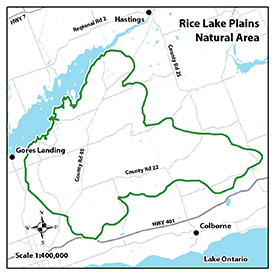Rice Lake Plains Natural Area
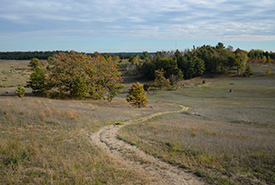
Beautiful vistas await at Hazel Bird Nature Reserve. (Photo by Chelsea Marcantonio)
Why this place is important
The rolling hills of the Rice Lake Plains Natural Area lie in the heart of a historical tall grass landscape, which has all but disappeared. The high, dry sandy hills of the Oak Ridges Moraine once offered vistas of wide expanses of tall grass prairie and oak savannah, dominated by massive black and white oak. Grasses like big bluestem, Indian grass and switchgrass grew more than two metres high, and a diverse range of wildflowers blossomed.
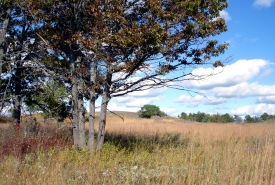
Black oaks on the prairie and savannah, Rice Lake Plains, Ontario (Photo by NCC)
Today, these temperate tallgrass prairie and oak savannah ecosystems have virtually vanished. Only 10 per cent of their original size remains in North America, and less than 2 per cent remains in Ontario. And what is left is badly fragmented and overgrown with non-native species.
What NCC is doing here
Since 2002, the Nature Conservancy of Canada (NCC) has helped lead the Rice Lake Plains Partnership (RLPP) — a collaborative collection of private landowners, Alderville First Nation, conservation groups and governments that have banded together to protect and restore the Rice Lake Plains.
Through a combined effort of prescribed burns, cutting and hand pulling, NCC, partners and volunteers are fighting back against the encroachment of non-prairie species, including invasive Scotch pine. Pockets of natural prairie and savannah are still intact and more are being established through direct seeding and planting projects. We are using the seeds produced by these areas to encourage the return of native grasses and wildflowers. Through these efforts we hope to see an influx of native species, such as grassland birds and insects, to the area.
Donate today to support our ongoing conservation and stewardship work in the Rice Lake Plains Natural Area.
What lives here
These are some of the significant and at-risk species found in this natural area:
Amphibians and reptiles
- Eastern hog-nosed snake (threatened)
- Gray treefrog
- Midland painted turtle (special concern)
- Snapping turtle (special concern)
- Spring peeper
Birds
- Barn swallow (threatened)
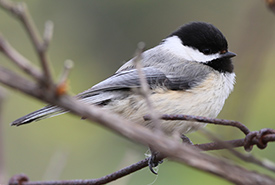
Black-capped chickadee, Hazel Bird Day, Rice Lake Plains, ON (Photo by Cameron Curran)
- Bobolink (threatened)
- Common nighthawk (special concern)
- Eastern meadowlark (threatened)
- Eastern whip-poor-will (threatened)
- Eastern wood-pewee (special concern)
- Grasshopper sparrow (special concern)
- Red-headed woodpecker (special concern)
- Wood thrush (special concern)
Insects
- Ghost tiger beetle (imperiled)
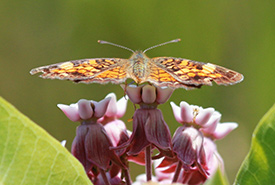
Pearl crescent, butterfly count, Rice Lake Plains, ON (Photo by NCC)
- Mottled duskywing (endangered)
- Monarch (special concern)
Plants
While not at risk, the following plant species are a significant indicator of tallgrass prairie species.
- Big bluestem
- Indian grass
- Little bluestem
- New Jersey tea
- Prairie buttercup
- Prairie cinquefoil
- Prairie smoke
- Round-headed bush clover
- Seneca snakeroot
- Smooth wild rose
- Thimbleweed
- Wild bergamot
- Wild lupine
Threats
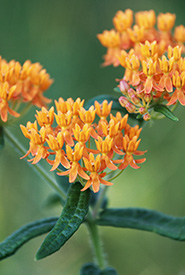
Butterfly milkweed, Rice Lake Plains, ON (Photo by NCC)
For most landscapes, fire is often seen as a threat. In the tallgrass prairie and oak savannah ecosystems, it is the absence of fire, or fire suppression, that is causing damage to these at risk ecosystems. Decades of fire management practices have paved the way for shrubs and trees to dominate what was once a thriving grassland. Without the natural disturbance cause by fire, both native, and especially invasive species have encroached on the landscape, crowding out black and white oaks, big bluestem and switchgrass. Non-native Scotch pine, European buckthorn, dog-strangling vine and other invasive plants have worsened the problem.
Now, with the help of partners and trained professionals, NCC has brought fire back to the Rice Lake Plains. Each spring, under very specific and heavily monitored conditions, stewardship staff and contractors set the plains ablaze. These prescribed burns are “low-intensity,” meaning that the flames stay close to the ground and are easy to control. This kind of fire kills young trees and shrubs that are beginning to fill in open areas, but full-grown trees such as black oak and white pine survive. It also prepares the soil for rare native wildflowers and grasses.
History
The Rice Lake Plains have a deep history. Known as Pemadashdakota or "lake of the burning plains," Rice Lake and the surrounding area have deep cultural and historical significance to the Indigenous Peoples who continue to call this area home.
English-Canadian pioneer, author and naturalist Catharine Parr Traill vividly described one of Canada’s easternmost prairies in her writings.
“There lies, between the Rice Lake and the Ontario, a deep and fertile valley, surrounded by lofty wood-crowned hills…This beautiful and highly picturesque valley is watered by many clear streams….The high sloping hills surrounding the fertile vale…were clothed with the blossoms of the gorgeous scarlet enchroma, or painted-cup.” Canadian Crusoes, by Catharine Parr Traill, published 1852.
Come visit us!
Four seasons of exploration await at this property, which is part of the Rice Lake Plains. Don your walking shoes — or, in winter, your snowshoes — and wander your way along the main loop trail that passes through tall grass prairie, sand barren, oak woodland and black oak savannah. Take in the beautiful views of the open grasslands as well as the broader Oak Ridges Moraine landscape to the west.
Visit in spring for the returning birds and the wildflowers, or in summer for the grassland bird viewing and vistas. Fall colours in Ontario never disappoint and here you can see the subtle lavender colour of the white oak. Complete your snow-filled winter by spotting woodland wildlife tracks.
Signage along the trail helps tell the story of the natural and cultural history of the Rice Lake Plains, including the Indigenous history that is so deeply entwined with the tallgrass ecosystems in the area.
Learn more about the Hazel Bird Nature Reserve Nature Destination.
Partners
The protection of the Rice Lake Plains is not something we can achieve on our own. Only through strong partnerships can this unique area continue to grow and thrive. NCC would like to thank the following partners for their collaboration and generous support of our ongoing efforts in this natural area:
- Alderville First Nation- Alderville Black Oak Savanna
- Environment and Climate Change Canada
- Fleming College's School of Environmental and Natural Resource Sciences
- Ganaraska Conservation
- Lone Pine Land Trust
- Lower Trent Conservation
- Ministry of Natural Resources and Forestry
- Northumberland County
- Northumberland Land Trust
- Ontario Parks
- Ontario Trillium Foundation
- Tallgrass Ontario
- Willow Beach Field Naturalists
Working with Indigenous communities
NCC is working in collaboration with the Alderville First Nation to take care of the land here and the species that rely on it. In addition to an annual butterfly count and prairie day hosted with the Nation, we have worked together to map host plants for mottled duskywing in the area. A species at risk, this work contributes to the recovery of this butterfly in the Rice Lake Plains.
We have also collaborated on native seed collecting in the area that is then transported to another site to ensure species are being distributed adequately, creating stable populations of native plants across the Rice Lake Plains.


